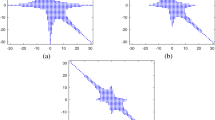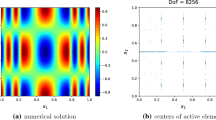Abstract
We consider retarded boundary integral formulations of the three-dimensional wave equation in unbounded domains. Our goal is to apply a Galerkin method in space and time in order to solve these problems numerically. In this approach the computation of the system matrix entries is the major bottleneck. We will propose new types of finite-dimensional spaces for the time discretization. They allow variable time-stepping, variable order of approximation and simplify the quadrature problem arising in the generation of the system matrix substantially. The reason is that the basis functions of these spaces are globally smooth and compactly supported. In order to perform numerical tests concerning our new basis functions we consider the special case that the boundary of the scattering problem is the unit sphere. In this case explicit solutions of the problem are available which will serve as reference solutions for the numerical experiments.










Similar content being viewed by others
Notes
Note that this choice of \(f\) is by no means unique. In [11, Sec. 6.1], \(C^{\infty }(\mathbb R ) \) bump functions are considered (in a different context) which have certain Gevrey regularity. They also could be used for our partition of unity.
References
Abramowitz, M., Stegun, I.: Handbook of Mathematical Functions. Applied Mathematics Series, vol. 55. National Bureau of Standards, U.S. Department of Commerce (1972)
Babuška, I., Melenk, J.: The partition of unity method. Int. J. Numer. Methods Eng. 40, 727–758 (1997)
Bamberger, A., Ha Duong, T.: Formulation Variationnelle Espace-Temps pur le Calcul par Potientiel Retardé de la Diffraction d’une Onde Acoustique. Math. Methods Appl. Sci. 8, 405–435 (1986)
Banjai, L.: Multistep and multistage convolution quadrature for the wave equation: algorithms and experiments. SIAM J. Sci. Comput. 32(5), 2964–2994 (2010)
Banjai, L., Melenk, J., Lubich, C.: Runge–Kutta convolution quadrature for operators arising in wave propagation. Numer. Math. 119(1), 1–20 (2011)
Banjai, L., Sauter, S.: Rapid solution of the wave equation in unbounded domains. SIAM J. Numer. Anal. 47, 227–249 (2008)
Banjai, L., Schanz, M.: Wave propagation problems treated with convolution quadrature and BEM. Preprint 60/2010, MPI Leipzig.
Birgisson, B., Siebrits, E., Peirce, A.: Elastodynamic direct boundary element methods with enhanced numerical stability properties. Int. J. Numer. Methods Eng. 46, 871–888 (1999)
Bluck, M., Walker, S.: Analysis of three dimensional transient acoustic wave propagation using the boundary integral equation method. Int. J. Numer. Methods Eng. 39, 1419–1431 (1996)
Chen, Q., Monk, P., Wang, X., Weile, D.: Analysis of convolution quadrature applied to the time-domain electric field integral equation (2012, submitted)
Chernov, A., von Petersdorff, T., Schwab, C.: Exponential convergence of hp quadrature for integral operators with Gevrey kernels. ESAIM Math. Model. Numer. Anal. (M2AN) 45(3), 387–422 (2011)
Davies, P., Duncan, D.: Averaging techniques for time-marching schemes for retarded potential integral equations. Appl. Numer. Math. 23, 291–310 (May 1997)
Davies, P., Duncan, D.: Numerical stability of collocation schemes for time domain boundary integral equations. In: Carstensen, C. (ed.) Computational Electromagnetics, pp. 51–86. Springer, Berlin (2003)
Ding, Y., Forestier, A., Ha Duong, T.: A Galerkin scheme for the time domain integral equation of acoustic scattering from a hard surface. J. Acoust. Soc. Am. 86(4), 1566–1572 (1989)
Dodson, S., Walker, S., Bluck, M.: Implicitness and stability of time domain integral equation scattering analysis. ACES J. 13, 291–301 (1997)
El Gharib, J.: Problèmes de potentiels retardés pour l’acoustique. PhD thesis, École Polytechnique (1999)
Gradshteyn, I.: Table of Integrals, Series, and Products. Academic Press, New York (1965)
Ha-Duong, T.: On retarded potential boundary integral equations and their discretisation. In: Topics in Computational Wave Propagation: Direct and Inverse Problems. Lecture Notes in Engineering and Computer Science, vol. 31, pp. 301–336. Springer, Berlin (2003)
Ha-Duong, T., Ludwig, B., Terrasse, I.: A Galerkin BEM for transient acoustic scattering by an absorbing obstacle. Int. J. Numer. Methods Eng. 57, 1845–1882 (2003)
Hackbusch, W., Kress, W., Sauter, S.: Sparse convolution quadrature for time domain boundary integral formulations of the wave equation by cutoff and panel-clustering. In: Schanz, M., Steinbach, O. (eds.) Boundary Element Analysis, pp. 113–134. Springer, Berlin (2007)
Hackbusch, W., Kress, W., Sauter, S.: Sparse convolution quadrature for time domain boundary integral formulations of the wave equation. IMA J. Numer. Anal. 29, 158–179 (2009)
Nédélec, J.C., Abboud, T., Volakis, J.: Stable solution of the retarded potential equations. In: Applied Computational Electromagnetics Society (ACES) Symposium Digest, 17th Annual Review of Progress, Monterey (2001)
Rynne, B., Smith, P.: Stability of time marching algorithms for the electric field integral equation. J. Electromagn. Waves Appl. 4, 1181–1205 (1990)
Sauter, S., Schwab, C.: Boundary Element Methods. Springer Series in Computational Mathematics. Springer, Berlin (2010)
Sauter, S., Veit, A.: A Galerkin method for retarded boundary integral equations with smooth and compactly supported temporal basis functions. Part II: implementation and reference solutions. Preprint 03–2011, Universität Zürich
Stephan, E., Maischak, M., Ostermann, E.: Transient boundary element method and numerical evaluation of retarded potentials. In: Computational Science—ICCS 2008, vol. 5102, pp. 321–330. Springer, Berlin (2008)
Todorov, P.: New explicit formulas for the \(n\)th derivative of composite functions. Pac. J. Math. 92(1), 217–236 (1981)
Trefethen, L.: Is Gauss quadrature better than Clenshaw–Curtis? SIAM Rev. 50, 67–87 (February 2008)
Veit, A.: A MATLAB code for computing exact solutions of retarded potential equations for a spherical scatterer (2011). https://www.math.uzh.ch/compmath/?exactsolutions
Wang, X., Wildman, R., Weile, D., Monk, P.: A finite difference delay modeling approach to the discretization of the time domain integral equations of electromagnetics. IEEE Trans. Antennas Propag. 56(8), 2442–2452 (2008)
Weile, D., Ergin, A., Shanker, B., Michielssen, E.: An accurate discretization scheme for the numerical solution of time domain integral equations. IEEE Antennas Propag. Soc. Int. Symp. 2, 741–744 (2000)
Weile, D., Pisharody, G., Chen, N., Shanker, B., Michielssen, E.: A novel scheme for the solution of the time-domain integral equations of electromagnetics. IEEE Trans. Antennas Propag. 52, 283–295 (2004)
Weile, D., Shanker, B., Michielssen, E.: An accurate scheme for the numerical solution of the time domain electric field integral equation. IEEE Antennas Propag. Soc. Int. Symp. 4, 516–519 (2001)
Wildman, A., Pisharody, G., Weile, D., Balasubramaniam, S., Michielssen, E.: An accurate scheme for the solution of the time-domain integral equations of electromagnetics using higher order vector bases and bandlimited extrapolation. IEEE Trans. Antennas Propag. 52, 2973–2984 (2004)
Acknowledgments
Thanks are due to Christoph Schwab for fruitful discussions concerning the use of the PUM for the time discretization.
Author information
Authors and Affiliations
Corresponding author
Additional information
A. Veit gratefully acknowledges the support given by SNF, No. PDFMP2_127437/1.
Appendix A: Technical estimates
Appendix A: Technical estimates
In this section we want to estimate the \(n\)th derivative of the function \(f\) as defined in (3.5). Therefore let
such that \(f:=h\circ 2g\). Note that [1, (7.1.19)] implies
where \(H_{n}\) are the Hermite polynomials. Hence,
Lemma 8.1
(Derivatives of \(g\)) It holds
where
Furthermore, we have
as well as the more generous estimate
with \(q( x) = \ln \frac{4}{1-x^{2}}\).
Lemma 8.2
(Derivative of composite functions) For \(n\ge 1\) and \(x\in ( -1,1) \) we have
where
and
Proof
The representation (8.4a) and (8.4b) follows from [27, formulae (2), (7)], while (8.5) is proved by induction using Leibniz’ product rule for differentiation. \(\square \)
Lemma 8.3
(Estimate of derivatives of composite functions) For \(n\ge 1\) and \(x\in ( -1,1) \) we have
with \(\kappa \approx 1.086435\) and \(C_{1}=6\sqrt{2}\text{ e}\).
Proof
From (8.3) and (8.5) we conclude for all \(n\ge 1\), \(\nu \ge 1\), and \(x\in (-1,1) \)
Thus, from (8.4b) we get that
From [1, (22.14.17)] we obtain
The combination of (8.4a) and (8.4b), (8.5), (8.7) and (8.8) results in the estimate for the \(n\)th derivative of \(\text{ e}^{-4g^{2}(x) }\):
\(\square \)
Theorem 8.4
(Estimate of \(n\)th derivative of \(f\)) We have
with \(C_{2}=\frac{10\kappa }{\sqrt{\pi }} \frac{C_1\ln (4)}{C_1\ln (4)-2}\).
Proof
From (8.1), (8.2) and (8.6) we get
which leads to the desired result. \(\square \)
Lemma 8.5
For \(x\in (-1,1)\) and \(\alpha \ge 2\), we have
with
Proof
We set
where
With the definition of \(\text{ arctanh}(x)\) we get
Since \(s_n(x)\) is symmetric we assume \(0\le x < 1\) and get
\(\tilde{s}_n(x)\) is strictly increasing in the interval \([0,0.5]\) for arbitrary \(\alpha \in \mathbb R _{\ge 2}\). Therefore we may restrict to find an upper bound for \(\tilde{s}_n(x)\) in the interval \([0.5,1[\). With the inequality \(\ln (1+x)\ln (1-x)\le -\ln (-\ln (1-x))\) we get
in \([0.5,1[\). The derivative of \(\hat{s}_n(x) \) is given by
which has the root
where \(\theta _\alpha := \frac{1}{2}\alpha +\frac{1}{2}\sqrt{\alpha ^2-4}\). Inserting this above shows that
which leads to the desired result after some straightforward manipulations. \(\square \)
Lemma 8.6
It holds
for \(n\in \mathbb N \).
Proof
We first note that
where we used [17, (2.711)] in the last step. With these computations we get
\(\square \)
Rights and permissions
About this article
Cite this article
Sauter, S., Veit, A. A Galerkin method for retarded boundary integral equations with smooth and compactly supported temporal basis functions. Numer. Math. 123, 145–176 (2013). https://doi.org/10.1007/s00211-012-0483-7
Received:
Revised:
Published:
Issue Date:
DOI: https://doi.org/10.1007/s00211-012-0483-7




